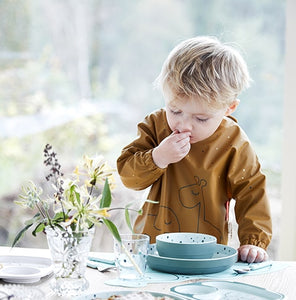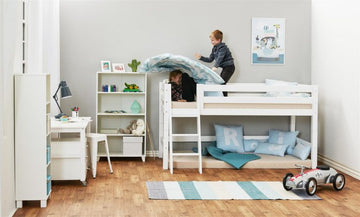You may have heard a couple of times that it's important to have a good indoor climate. Perhaps you have already incorporated a lot of good habits into your daily life. But did you know that it actually doesn't have to be particularly complicated? We have gathered a lot of good advice to get started!
It is especially about the air, the temperature, the furniture – and then all those little things, like toys and bedding. Indoor climate is the sum of many things – and fortunately, it is easy to do something about it already today!
The Temperature
Many of us adults like a slightly cool bedroom. Therefore, it can be quite natural to think that a lower temperature will give your child a better night's sleep.
Cold does not automatically create a better indoor climate, even though the cold air can sometimes feel fresher. According to sleep researcher Poul Jennum, it is not necessarily a cool room that is best for the child.
However, according to Jennum, you have a very wide spectrum on the temperature scale to work with when you set the radiator in your child's bedroom. The temperature in the bedroom just needs to be between 15-22 degrees, and then the little one should get a good and healthy night's sleep.
If you would like to know a bit about the nerdy side of the reasoning behind Jennum's answer, it is because the body at a higher temperature will use energy to produce sweat to get rid of some heat. If the temperature is too cool, the body uses a lot of energy to keep warm.
But remember, there is certainly no reason to sound the alarm bells if you think about the fact that your child's bedroom has been too warm or too cool – you would have noticed if something was wrong. In the future, you can just start thinking a little about it when you adjust the radiator or leave the window open =)
The Air – The Most Important Factor in the Room's Indoor Climate
It is clear that the air affects the indoor climate in the room. After all, it is in the air that many particles, etc., are found, and therefore it is of course smart to ventilate.
Ventilation changes the air in the room and thus lowers the level of CO2 in the room. People surprisingly emit a lot of CO2 during one night's sleep, and therefore there is a need for a new supply of air every day.
Throughout the day, it is a really good idea to open the windows for 5-10 minutes at a time. You can do this 2-3 times a day, especially in the morning and just before bedtime. When it's time for your child to go to bed, leave the door ajar or use the ventilation system if you have one installed.
The reason it can be a good idea to ensure good ventilation is that your child's performance increases. You may have also experienced firsthand that work or education just goes better if you have slept well. In the same way, your child will have a slightly more enjoyable day if their sleep is as it should be. That said, there is of course a lot of other factors that also play a role. There is hardly anything that gives your child a better day than the love you show every single day <3.

Furniture
While we were sitting and doing research for this article, the topic here surprised us a little regarding the impact of indoor climate. Although it seems logical, we hadn't really considered that all the things in the room also stand and emit chemicals throughout the day.
Furniture with environmental certifications, such as the Swan Label, ensures that there are no unnecessary chemicals in the products. All furniture certified with the Swan Label must meet a long list of strict requirements regarding, among other things, the surface treatment and glue used in the product.
Hoppekids makes Swan-labeled beds for children of all ages – and before the furniture leaves the factory, it gets to off-gas, so you get a piece of furniture ready for use.
READ ALSO: Swan-labeled children's beds from Hoppekids
If the furniture hasn't already off-gassed when you receive it, it's a good idea to do so before you start using it. You can check by "sniffing" a little at the furniture when you unpack it. If it smells strong, let it off-gas for a day. This way, you avoid the worst irritants and also get a more pleasant indoor climate. You can place the furniture outside or in a room with good ventilation. The same applies if you have just painted – by the way – let it dry completely and off-gas before you move into the room.
Bedding
The bedding is close to your child's body for an entire night, so it should naturally also be in order. This applies to both the duvet, pillow, and bedding, by the way.
With duvets and pillows it might be a good idea to buy hypoallergenic ones and ensure to air and beat both pillows and duvets often. Avoid washing the duvets too often, as it can damage the filling – especially if it is natural filling, such as down and feathers.
See Mammashop's selection of hypoallergenic duvets and pillows here.
Mammashop has a selection of bedding that is either organic or certified with GOTS or Oeko-Tex. All three certifications ensure that the bedding is free from harmful substances and that there has been a focus on health in the production.
Bedding should be changed approximately once a month or as needed. Normally, you can easily wash it at 60 degrees, but after illness or if there has been vomit, urine, or feces on it, it is a good idea to wash it at 90 degrees.
See our entire selection of bedding here.
If you have the energy and opportunity – then hang the bedding outside. Your indoor climate will thank you – and if you have children who are old enough, there is free energy burning by letting them beat the pillows and duvet. It also helps for better sleep 😉
Those little things…
So, the gadgets in the room, such as toys. This is a category that is often overlooked because it is more of the toys that take up space in the room.
Just like with the furniture, toys also affect the indoor climate by emitting some substances. Therefore, it can be quite good to check the toys a little for seams. For example, in 2007, new legislation was introduced regarding the use of phthalates in toys. Therefore, there MAY be phthalates in old toys if you have some of them. The same applies to soft plastic products.
Fortunately, many toy manufacturers have started to take additives very seriously. For example, Danish PlanToys toys are made from reclaimed rubber trees to protect the environment. They also strive to keep glue, paint, etc. free from unnecessary chemicals.
Additionally, it's a good idea to put toys in boxes and other containers that can be closed. There are many places where dust can settle – and even if you work hard to clean and vacuum.
READ ALSO: 5 tips for a healthy junior room.
And remember – even the smallest change helps. You don't have to do it all at once. And if you forget to air out for a single day, it will be fine. There is just a lot to gain from establishing a few good habits 😊






















































































































































